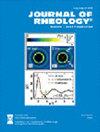边缘断裂透视
IF 3.2
2区 工程技术
Q2 MECHANICS
引用次数: 1
摘要
边缘断裂是一种粘弹性不稳定性,其特征是当流体受到足够高的剪切速率时,流体的自由表面突然凹陷。在剪切流变测量过程中,裂缝会侵入流体样品,减少其与流变仪夹具的接触面积,使高剪切速率下的粘度和法向应力测量无效。边缘断裂还会在流体中引起明显的剪切带,使实验结果的解释复杂化。在过去的几十年里,经验和理论研究已经揭开了边缘断裂的物理基础。所获得的知识使流变学家能够在实验中开发出最小化断裂不利影响的技术。近年来,边缘断裂也被用于快速清洁地破坏粘弹性液体桥,显示出其适应功能性点胶喷嘴设计的潜力。这篇展望文章旨在对边缘断裂的历史进行概述,并提出研究方向,以开发抑制或利用这种现象的方法,从而使基础和技术的应用都具有重要意义。本文章由计算机程序翻译,如有差异,请以英文原文为准。
Perspective on edge fracture
Edge fracture is a viscoelastic instability characterized by the sudden indentation of a fluid’s free surface when the fluid is subjected to a high enough shear rate. During shear rheometry, the fracture can invade the fluid sample, decreasing its contact area with the rheometer fixture and rendering the measurement of viscosity and normal stresses at high-shear rates invalid. Edge fracture can also induce apparent shear banding in the fluid, complicating the interpretation of experimental results. Over the past several decades, empirical and theoretical research has unraveled the physics underlying edge fracture. The knowledge obtained has allowed rheologists to develop techniques to minimize the adverse effect of fracture in their experiments. In recent years, edge fracture has also been used to break up viscoelastic liquid bridges quickly and cleanly, showing its potential to be adapted to the design of functional dispensing nozzles. This Perspective article aims to give a historical overview of edge fracture and suggests research directions to develop methods for suppressing or harnessing the phenomenon to benefit applications of both fundamental and technological importance.
求助全文
通过发布文献求助,成功后即可免费获取论文全文。
去求助
来源期刊

Journal of Rheology
物理-力学
CiteScore
6.60
自引率
12.10%
发文量
100
审稿时长
1 months
期刊介绍:
The Journal of Rheology, formerly the Transactions of The Society of Rheology, is published six times per year by The Society of Rheology, a member society of the American Institute of Physics, through AIP Publishing. It provides in-depth interdisciplinary coverage of theoretical and experimental issues drawn from industry and academia. The Journal of Rheology is published for professionals and students in chemistry, physics, engineering, material science, and mathematics.
 求助内容:
求助内容: 应助结果提醒方式:
应助结果提醒方式:


